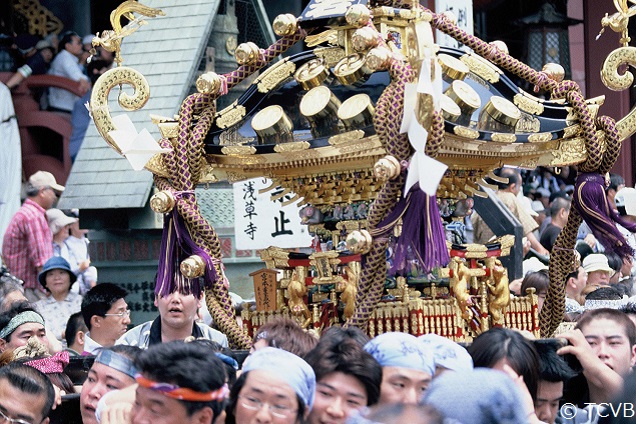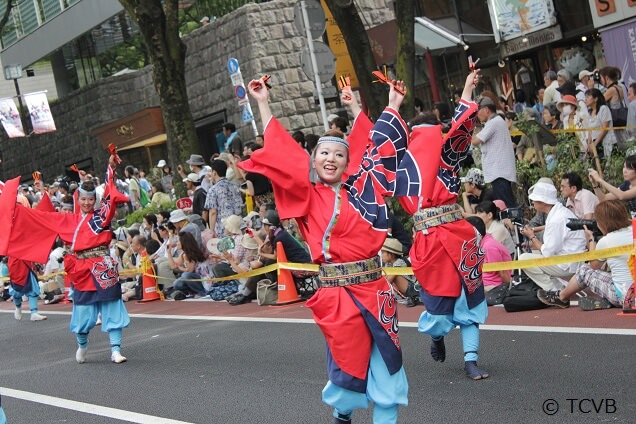-
- USA/Canada 1-800-285-2726
- Australia (02) 8006 4411
Japan is very proud of its four distinct seasons: clear, cold, and sometimes snowy winters melt into blossom-laced springs; summers are tropically hot, and the cooling autumns are aflame with turning leaves. Seasonal changes permeate the culture, making their way into fashion and food, and are marked by the traditional celebrations that punctuate the year.
There are countless local festivals (matsuri) in Japan because almost every shrine celebrates one of its own. Most Japanese festivals are held annually and celebrate the shrine's deity or a seasonal or historical event. Some festivals are held over several days. Important elements of Japanese festivals are processions, in which the local shrine's kami (Shinto deity) is carried through the town in mikoshi (palanquins). It is the only time of the year when the kami leaves the shrine to be carried around town. Many Japanese festivals also feature decorated floats (dashi), which are pulled through the town, accompanied by drum and flute music by the people sitting on the floats. Every festival has its own characteristics. While some festivals are calm and meditative, many are energetic and noisy.
The year starts on January 1st, celebrated with family and symbolic food. At midnight on December 31st, people gather at temples to ring out the old year on giant bronze bells; and the trains run all night, allowing a first visit to a Shinto Shrine - often in kimono - to pray for luck and success in the New Year.
Spring is Japan's best known season, with Japanese cherry blossom (sakura), front moving up the country like a pink tide. Japanese cherry blossoms generally reach their peak in Kyoto and Tokyo in the last week of March, and higher altitudes and latitudes follow gradually, with the blossoms reaching the northern island of Hokkaido in the beginning of May. Sakura season is generally celebrated with alcoholic picnics beneath the flowering cherries, kimono-ed tea parties, and the spring Geisha Dances in Kyoto.
Summer brings hot days and nights filled with fireworks. The summer Obon festival is celebrated with evening Bon-Odori dancing, and neighborhoods are filled with paper lanterns, yukata-clad dancers, and the deep beat of the taiko drums.
As the seasons turn to fall, the air cools and fruits ripen in the mountain orchards. On the hillsides and in gardens the leaves begin to change color, and people go hunting autumn leaves
with their cameras, and picnic under the trees.
Small Open-Air Food Stands selling street food like Takoyaki and Chocolate Banana
Informal, unlined kimono made of cotton
Japanese matsuri games are similar to carnival games.
A happi is a traditional Japanese robe with the family crest or mon printed on the back.
The Takayama Festival (Takayama Matsuri) is ranked as one of Japan's three most beautiful festivals. It is held twice a year in spring and autumn in the old town of Takayama and attracts large numbers of spectators. The Spring Festival (April 14-15) is the annual festival of the Hie Shrine in the southern half of Takayama's old town. While the shrine is also known as Sanno-sama, the spring festival is also called Sanno Festival. Likewise, the Autumn Festival (October 9-10) is the annual festival of the Hachiman Shrine in the northern half of the old town, and the festival is also known as Hachiman Festival. The spring and autumn festivals have similar attractions and schedules. Each festival features its own set of about a dozen festival floats (yatai). During the year, the tall and heavily decorated floats are stored in storehouses, which are scattered across Takayama's old town (except the floats exhibited in the Yatai Kaikan).
View >>> Takayama Festival Tours - Japan Festival Tours
Kyoto Gion Matsuri, the festival of Yasaka Shrine, is the most famous Japanese festival. It takes place over the entire month of July. There are many different events, but two are particularly renowned: the Yamaboko Junko, a procession of floats on July 17th; and Yoiyama, the festive evenings preceding the procession.
View >>> Kyoto Gion Festival Tours - Japan Festival Tours

The Mikoshi (portable shrine) are an important part of the Sanja Festival. The three paraded on the final day act as a portable Asakusa Shrine, with up to 500 people carrying one through out the day. These shrines are always swarmed with people because of their importance, with many fighting for a chance to carry the shrine. These extravagant portable shrines are not only an honor to lift, but they also are carefully decorated and crafted, costing upwards of forty million yen. There are also another 100 smaller mikoshi paraded during this festival, some carried exclusively by women or children. No matter the mikoshi size, everyone participating is filled with excitement and a wild energy that's infectious.

This festival is held in August every year. About 100 teams, about 5,000 dancers, gathered from all over the country, they dance yosakoi dance in Omotesando street. The Yosakoi Festival was established for economic recovery and regional development in 1954 in Kochi.
The music instrument called naruko, gorgeous music and clothing are feature of Yosakoi.
Hanami - flower viewing is the Japanese traditional custom of enjoying the transient beauty of flowers, flowers - hana in this case almost always referring to those of the cherry - sakura or, less frequently, plum ("ume") trees. Other Japanese flowers are also celebrated and revered, making Japan a great travel destination for fans of flowers and nature. If you're a fan of Japanese flowers and can't make it for our Sakura Cherry Blossom Japan Tours, Japan Deluxe Tours Japan Kawachi Wisteria Flower Garden & Hiroshima Festival Tour may be the perfect vacation for you!
Early Hanami in Izu Peninsula
Festival in Okayama featuring beautifully bloomed wisteria flowers
800,000 shibazakura or pink moss cover the fields in shades of pink
People Gather Every Year to View the 8,500 Azalea Bloom
Considered one of the best places to view cherry blossoms in Tokyo
Lake Kawaguchi Cherry Blossom Festival
Tohoku is famous for it's Big Three Summer Festivals held between the months of July and August. While Japanese festivals are always fun and lively events, the Big Three Summer Festivals of Tohoku are well-known for bright colors, festive music, delicious food, and a wonderful environment you can't help but enjoy. Japan Deluxe Tours is more than happy to arrange a custom Japan tour to partake in Tohoku's best summer festivals.
Tohoku Festival,The gigantic bamboo framed lanterns are displayed
One of the four greatest festivals in Tohoku, held every summer in Sendai
Pole lantern festival in Akita, held every August 3-6

When it comes to summer, nothing beats a fireworks display in Japan. Sparks of brilliant colors and roars vibrating the night sky have been a seasonal feature in Japan for centuries. Known for dazzling colors and spectacular shows, Japan's reputation for fireworks shows is one of the best in the world! Each fireworks are made into shells called Tama and are filled with gunpowder called Hoshi. These carefully crafted explosives are then shot into the sky with cannons by professional craftsmen to put on a spectacular show to enjoy during your vacation. Enjoy the sights and sounds of Japan during a fireworks Japanese festival this summer with Japan Deluxe Tours and our flexible day-trips to add a Fireworks Matsuri in Tokyo to your tour!
One of Japan's Largest Fireworks Festivals with 9,500 fireworks
Thousands of bamboo lanterns illuminate the town and rivers
Shunsetsu Festival and celebrates Chinese New Years
Graceful dance featuring women carrying lanterns on their heads
While there are numerous festivals to celebrate in Japan for shrines and temples, Japan is also home to other festivals that showcase the country's dynamic culture. Some festivals focus on Quilting & Japanese crafts, anime and manga, winter season snow sculpture events, samurai battles and Japanese history, and even festivals for dances and dancing. Each celebration brings travelers from across Japan and even around the world to enjoy the thrills and fun of a Japanese matsuri. Browse through various Japanese festivals and find the perfect Matsuri Japan tour with Japan Deluxe Tours. You can also customize a vacation package to include time at a Japanese festival for a tailor-made Japan experience!
The Largest Quilt Show in the World
The Largest Anime Festival in the World
One of Japan's largest winter festivals in Hokkaido, Sapporo
Yomemi Matsuri is an Akita festival which literally translates to Bride-seeing Festival
Fukushima Waraji Matsuri (Straw Sandal Festival) is a two day festival held early August
A symbolic event with over 10,000 dancers.
Festival to commemorate the anniversary of the founding of Kyoto
Battle reenactment between Yamanashi's warlord Takeda Shingen, and his rival Uesugi Kenshin
Fairy story themed festival of Oita on Children's Day
High energy dance held in line with Obon.
Dance to Welcome The Ancestors' Spirits
Community Flower Event in Hokkaido